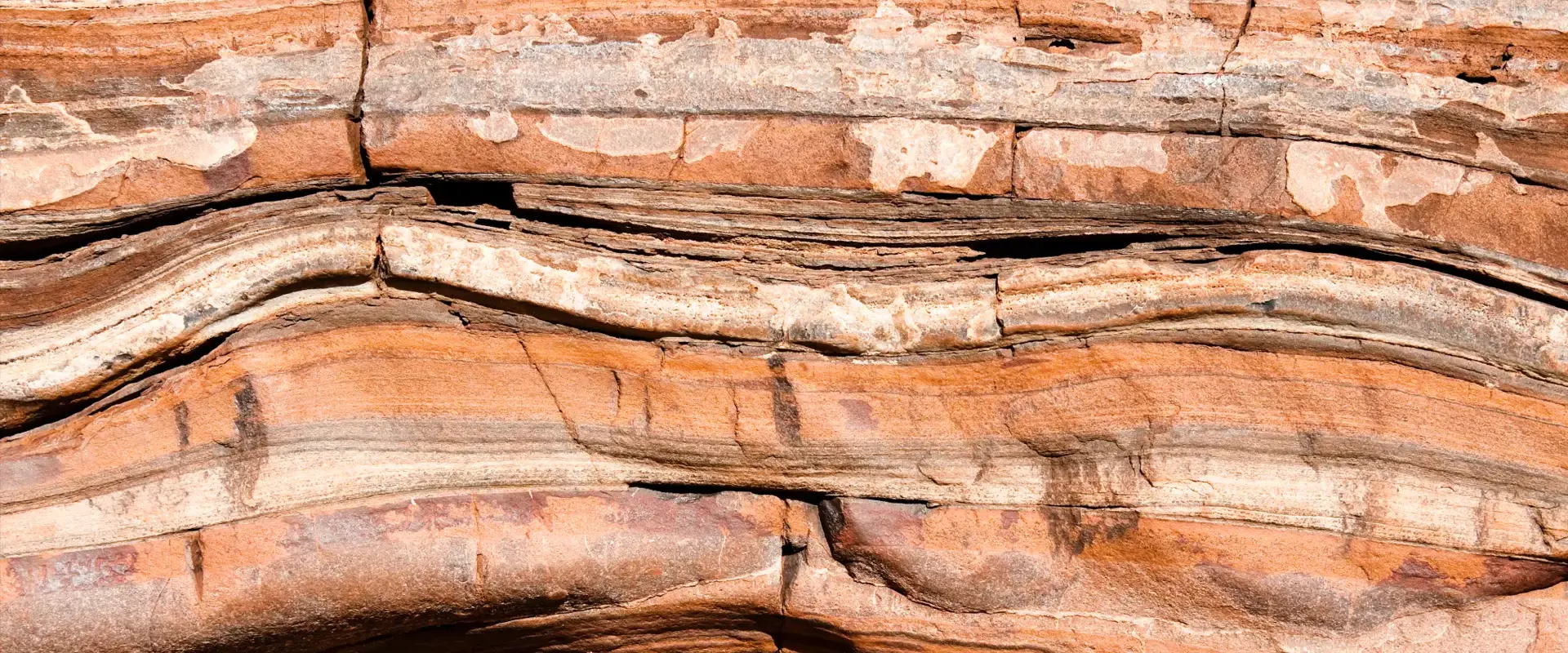
Navajo Sandstone, Arizona - United States
The Wave Navajo sandstone formation in Arizona: © Gb11111
The Navajo sandstone is estimated to cover 400,000 km2 of the western United States and is found spread across the states of Nevada, Arizona, Colorado and Utah as part of the Colorado Plateau. The formation consists of thick layers of highly-angled cross-bedded sandstones, just like those found at Alderley edge. The rocks are predominantly composed of rounded quartz grains and were formed in a vast ancient desert of sand dunes, or erg, similar to the modern Sahara Desert.
The Navajo Sandstone is one of the most extensive and most exposed aeolian (wind-blown) systems known in the geologic record. This enormous sand sea was deposited in the Early Jurassic, approximately 190 million years ago, as a result of regional tectonics and mountain building in what is now the western United States.
During the Early Jurassic the Colorado Plateau region was part of a large sedimentary basin located between 10-20° north of the equator in an extremely arid climate. This basin is thought to have formed due to the downward flexing of the lithosphere in response to an accumulation of mass in the developing North American Cordillera occurring on the western flank of the American plate. High rates of continued subsidence in the basin created more space and allowed more sediment to be deposited resulting in the accumulation of thick sedimentary successions. This subsidence also would have resulted in decrease in air pressure over the region which caused regional winds to decelerate, and deposit the fine sand particles they were carrying forming the huge desert of dunes.
 |
|
| Cross bedding in the Navajo Sandstone: © Zion National Park |
The dramatic cross-bedding structures found in the Navajo Sandstone provide a record of lee-ward deposition on the sand dunes and therefore display the history of ancient wind patterns and dune migration in the Early Jurassic Colorado Plateau. The orientation of these cross-bedding structures indicates that the dominant wind pattern during this time would have been from the north-northwest. However, radioisotopic dating of detrital zircon grains found in the Navajo Sandstones indicates that at least some of the sediment came from as far away as the ancient Appalachian Mountains of eastern North America. It is therefore thought that sediment would have been transported from the Appalachians westwards across most of North America by a huge continental-scale ancient river system, somewhat like the modern Mississippi river system, and then later blown by desert winds to the Colorado Plateau region.
South-westerly winds continue to sculpt and scour the geomorphology of the Navajo Sandstone today creating small-scale erosional bedforms as well as spectacular large-scale, U-shaped troughs such as ‘The Wave’ in Arizona.
Further reading:
Rahl et al. (2003) Combined single-grain (U-Th)/He and U/Pb dating of detrital zircons from the Navajo Sandstone, Utah, Geology
* Allen et al. (2000) Jurassic giant erg deposits, flexure of the United States continental interior, and timing of the onset of Cordilleran shortening, Geology
Loope and Mason (2009) Wind erosion of the wind-deposited Navajo Sandstone, USA Geology Today
Related Links
Other sites
- Twin: Windward Isles
Cwm Idwal
- Twin: Mount Pinatubo
Sperrin Mountains
- Twin: Sierra Nevada
Southern Uplands
- Twin: Nankai
Ben Arnaboll
- Twin: Glarus Thrust
Outer Isles
- Twin: Tohoku Earthquake
Clogherhead and Shannon
- Twin: Papua New Guinea
Cairngorms
- Twin: New Hampshire Granites
Great Glen Fault
- Twin: North Anatolian Fault
The Lizard
- Twin: Troodos Ophiolite
Yoredales
- Twin: Antarctica
Stanage Edge
- Twin: Ganges Delta
Hartland Quay
- Twin: Zagros Range
Amroth-Saundersfoot-Tenby
- Twin: Salt Range, Pakistan
Vale of Eden
- Twin: East African Rift Valley
Zechstein
- Twin: Sicily
Alderley Edge
- Twin: Navajo Sandstone
Isle of Skye
- Twin: Mount Kilimanjaro
Lulworth Cove
- Twin: Albania
Giant's Causeway
- Twin: Cascade du Ray Pic
